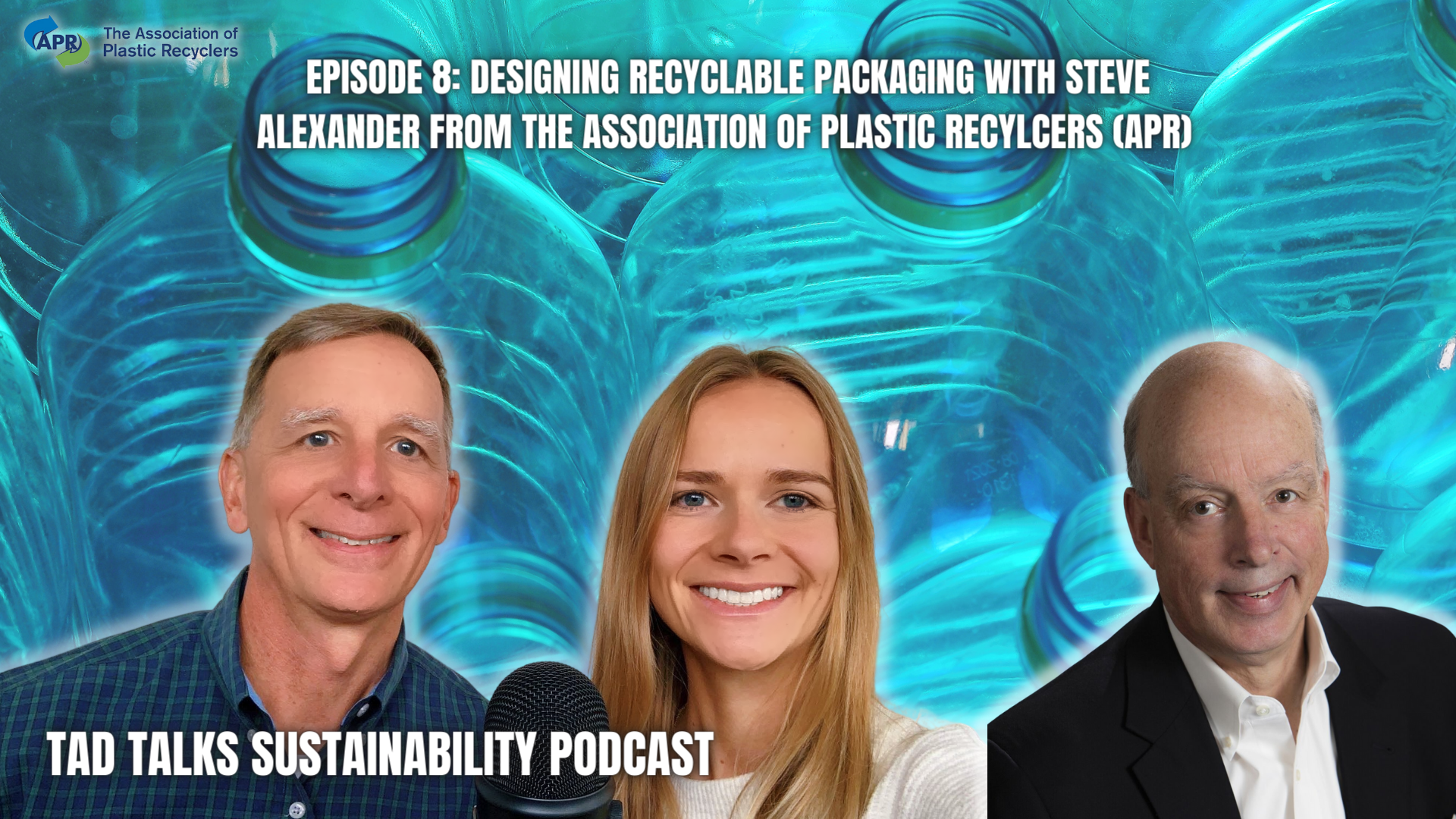Episode 8: Designing Recyclable Packaging with Steve Alexander from the Association of Plastic Recyclers (APR)
Click the links below to listen to the full episode
Designing recyclable packaging is essential for achieving a circular economy. In this episode, Tad and Julianna sit down with Steve Alexander, President and CEO of the Association of Plastic Recyclers (APR), to discuss the importance of the APR PCR Certification program, APR’s Design Guides for plastics recyclability, APR’s mission, the benefits of being an APR member, the necessity for recovering plastics, and the growing trend of polypropylene collection.
CAN YOU TELL US MORE ABOUT WHAT YOU DO WITH APR?
“Well, the simplest way to say it is that we are the technical soul of plastics recycling. APR’s Design Guides for plastics recyclability is one of the most referenced and authoritative guides to help a converter or packaging engineer designer create a package or an innovation to be compatible with recycling. We have testing protocols upon which a converter or a brand company can submit their innovation or the new package. Then they can go through the tests to determine whether or not it meets our design guides. They can also find out and whether or not it gets recognition as being compatible with recycling, through our recognition programs. When there's a problem or a contaminant in the plastics recycling world, we're the ones that try to solve it. We're the only trade association that all we do is plastics recycling. It's not part of what we do. It's, it's what we do each and every day. So we're a full-scale trade association. We have a design guide, we have our testing protocols, and we have a PCR certification program. We have a market demand development programs, and we also advocate for plastics recycling through our advocacy and lobbying efforts. So we are the full-scale representative for plastic recyclers, not just in this country, but also increasingly on an international scale as well.”
WHAT IS THE MISSION OF APR AND WHAt ARE YOU TRYING TO ACHIEVE?
“We always used to say ‘more good bottles, and more good material.’ The ultimate goal is you can't have circularity without recycling, so it has to be at the core of that. Our goal is to enable plastics packaging to be more sustainable and to be a primary contributor to the circular economy. It's frankly, as simple as that, it begins with design and consumer participation. When you talk about circularity in graduate school, we had a saying ‘garbage in, garbage out.’ If you're putting contaminated material in the marketplace, then you're contaminating the very stream of material upon which you want us to create recycling to be reused again, to be circular. It just goes to show that you really need to design your packaging to be recyclable so that you can help create the secondary use of that feed stock somewhere down the line. That's basically it, we want to help plastics packaging be circular.”
WHAT ARE THE BENEFITS OF BEING AN APR MEMBER?
“APR members participate in our technical committees. They also have insight and input into creating the solutions and dealing with whatever potential problem comes down on the pike. Of course from the advocacy arena, we've really ramped that up over the last few years. There's a lot of narrative in this space, and it may be well-meaning and maybe well-intentioned, but frankly, a lot of it is just flat out wrong. We're trying to be sort of a technical solution provider. When we see a legislative proposal, we prefer to go in and work with the sponsor to help them understand why it won’t actually won't work. We don't always succeed in that. Mostly we don't succeed in that because plastics recycling is very technical and there's a lot of rational thought put into it and a lot of science-based stuff which may not always be popular in terms of some decisions that would be made. That's sort of how we want to carve out that niche to be perceived as the technical expert in this arena.”
We heard a statistic RECENTLY THAT ONLY 9% OF DISCARDED PLASTICS ARE BEING RECYCLED GLOBALLY. SO WHY IS IT SO IMPORTANT THAT WE RECOVER THESE PLASTICS?
“Well, let's, let's talk about that. First of all, the plastic that has caused the great kerfuffle as I call it, is plastics that you and I use and handle. This is called post-consumer plastic. The post-industrial material, by and large, gets captured, recycled, and used. That is an efficient manufacturing process, and while that number is higher than 9%, it is still frustratingly inadequate and low. We, along with some other groups, do the Annual Recycling Rate report for PET and HDPE, and now we're incorporating polypropylene. You could argue that PET and HDPE, which are basically soda bottle resin, milk jug, and detergent resin. But, for 30 to 40 years, there has been some semblance of government-mandated collection programs for PET through deposit programs and for HDPE material, with the rigid plastic packaging container law in California, that essentially became a national standard. Yet we're only at 28% recycling rate for that material, and we're only capturing about 30% in our collection programs.
So let's start there. Design is critical, and participation is critical. Number one, because we know for instance, there's a major city in the Southeast, which has a very robust curbside collection program. We know that each individual household has about 77 pounds of PET in it every year, and somehow that passes through their home. Only 27 of those pounds go into this very robust, very well-established curbside collection program. What are we doing wrong? The labeling. The consumer brand companies, the recycling programs, and the recyclers do a great job at confusing the public. So one issue is participation. The other of course is design.
Brand owners can control three things. They can control the design of their product. They can control using and buying recycled content to monetize the system and to put money back into the infrastructure. Finally, they can control the narrative with the billions of dollars they spend every year telling consumers what they want around the recyclability of their products.
Then the other issue is how do you separate the material? Our infrastructure is basically based on prehistoric times, which is before 2012 in most people's minds these days. Because you think about the evolving ton. You think about how you've purchased Christmas presents this year. And last, the ton has changed. The makeup has changed. The composition has changed. The volume has grown dramatically. Asking a current Material Recovery Facility (MRF) to deal with the current volume and type of material is like asking a 1978 Chevrolet Chevette to meet current California emission standards.
So there are multiple reasons in that arena. And then you add in the fact that we have 20,000 communities in this country, 15,000 recycling programs, 9,000 that take different things. Consumers are confused and of course you throw in labeling and mislabeling a product. A lot of consumers don't pay attention to labels and whether or not products are recyclable anymore. So all of these problems comes together.”
CAN YOU TELL US MORE ABOUT ABOUT APR’S PCR CERTIFICATION PROGRAM?
“Well, there's a couple of parts to that. First of all, and we've done research that shows this, when you use the term recycled content on a package via post-industrial material, the consumer believes that it came from container that they've handled and placed in the recycling system. The problem we're trying to address is the problem with post-consumer plastic material. There is not a problem, as I indicated earlier, with post-industrial material or pre-consumer material. The problem is with post-consumer material, material that you and I deal with and then place in a curbside recycling program or unfortunately in the trash bin.
The major step to dealing with this problem is for us to certify a recycler through a chain of custody. Then they can credibly say to a potential customer that ‘this material is certified through the APR process with our third- party auditors, such as GreenCircle Certified, that it contains 95% recycled material post-consumer material.’ The third-party auditors verify that it comes from blue bins., it comes from drop-offs, and it is recycled. Then the brand can say with certainty, ‘this material is made with recycled content.’ Or they can say ‘it's made with post-consumer recycled content.’ That begins to solve the problem that we face with plastics packaging in the environment. Giving credit for material that is processed as post-industrial material does nothing to solve the problem of plastics packaging sustainability. This allows brands to make claims and mislead consumers. Their packaging may be made from recycled content, but it's not post-consumer content. And so we believe the pathway to plastics packaging sustainability starts with certified PCR programs, and we have it for the recyclers and we are getting requests from brands to have the brands go through the same process, which we'll be talking to you about in the very near future.”
DO YOU SEE THAT TREND OF CAPTURING MORE POLYPROPYLENE FROM THE POST-CONSUMER STREAM continuing to grow?
“I think the key there is for politicians to stay out of the way and let polypropylene continue to grow and be recovered. Polypropylene is the fastest growing material in the marketplace and demand far outweighs supply. There has been more investment in infrastructure to collect, segregate, and process polypropylene in 2021 to date, than ever before. There is so much capability coming about to process polypropylene. And yet you have policy proposals that restrict and remove polypropylene from statewide recycling lists. Polypropylene is absolutely the next, it's actually beyond the next great thing. It should be separated and recovered because there's a huge market for it, and it's getting a very high price. There is no reason not to collect and separate polypropylene at this point. It's a very usable material, and it's very flexible.”
ABOUT STEVE ALEXANDER
Steve Alexander serves as President and Chief Executive Officer of the Association of Plastic Recyclers-The Voice of Plastic Recyclers- a Washington, DC based trade association whose members represent more than 95% of the processing capacity for postconsumer plastics in North America. APR serves the plastics recycling industry by providing technical and educational solutions with a goal of creating more good supply of material for recycling and enhancing the quality of the existing supply stream.
Alexander is also the president of Resource Recycling, Inc., a publishing and conference management firm. Resource Recycling produces the Plastics Recycling Conference and Trade Show, and it is the publisher of three trade journals: Resource Recycling, Plastics Recycling Update and E-Scrap News.
Previously, Mr. Alexander spent more than 20 year representing corporate and association clients on Capitol Hill and in State Houses across the country, including 10 years with Eastman Kodak Company, where he specialized in environment, technology and appropriations issues.
He is a graduate of the University of Rhode Island, and holds an MBA from the Sellenger School of Business at Loyola College in Baltimore, Maryland.
He can be reached at steve@plasticsrecycling.org.






